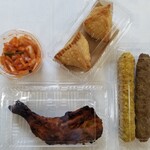
アジャンタ 西武池袋本店
Ajanta
3.18
Ikebukuro
「India cuisine」
1,000-1,999円
1,000-1,999円
東京都豊島区南池袋1-28-1 西武池袋本店 B1F
Photos
(20)

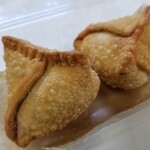
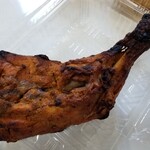
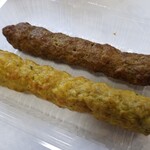
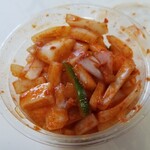


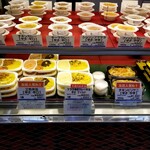
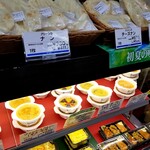
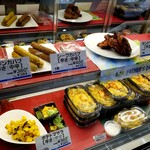
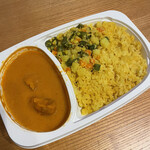
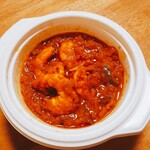
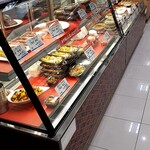
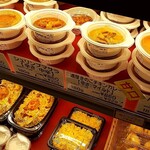
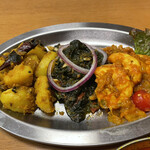
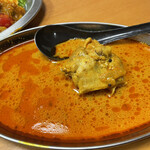
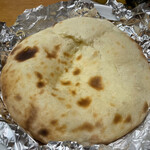
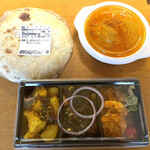

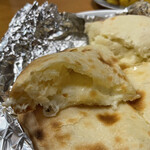
Details
Reservation Info
No Reservations
Payment Method
Credit cards accepted
Electronic money not accepted
Private Dining Rooms
None
Smoking and Non-Smoking
No smoking at the table
Parking
having
Comments
(21)
デイルス・マイビス
4.10
"Ajanta" located in the food section on B1F of Seibu Ikebukuro Main Store. It is a deli of a long-established Indian restaurant that opened in Kojimachi in 1957. They sell various curries, bento boxes, naan, biryani, tandoori chicken, and other side dishes. The items purchased this time are as follows: "Chicken Curry" 929 yen, "Cheese Naan" 540 yen, "Assorted South Indian Appetizers" 1059 yen. The appetizers include potato masala, spinach and garlic stir-fry, and shrimp masala. They are labeled as "spicy," but all have a pleasant level of spiciness. On the other hand, the Chicken Curry is solidly spicy. It has a deep spice flavor that becomes increasingly intense as you eat. The chicken in the curry is bone-in and tender. Despite being labeled as spicy, the appetizers and Chicken Curry have different levels of spiciness. The Cheese Naan is wrapped in foil and toasted for about 5 minutes. There isn't a lot of cheese, but it is fluffy and delicious. I have purchased from them when they had a limited-time pop-up shop before, and now that they have a permanent store, you can enjoy authentic South Indian cuisine anytime. It may not be cheap, but you can experience a truly authentic spice blend.




京夏終空
3.60
Established in 1957, a South Indian cuisine deli. Nowadays, you might call it "Authentic South Indian" (laughs). For more details, I'll leave it to the website, but in the section "Ajanta's Commitment," it states, "Above all, I wanted Japanese customers to taste the pure cuisine of my hometown, South India." That was Jay's (the owner) wish. Therefore, there are no adjustments made for Japanese customers. Since the gourmet boom was not yet present in the Showa era of the 30s up to the present, we have been supported by many repeat customers. In the section "Strict Inheritance of Taste," it is mentioned, "Ajanta's recipes have remained unchanged for over 50 years. For example, even when we invited chefs from top Indian restaurants, no adjustments were allowed." Yep, there's no doubt it's "Authentic South Indian" (laughs). Now, as for me, who is quoting such text, I am a complete novice when it comes to Indian cuisine. I know nothing about North or South, East or West. I simply liked the Naan curry restaurant run by Indians that opened in the alley behind the west exit of Ikebukuro Station more than 30 years ago, and have been eating at various other Indian restaurants that opened later. However, as these types of restaurants increased and I compared the food at each, I began to notice differences in ingredients, spiciness levels, variety of spices, stickiness of the curry, saltiness, and overall flavor. Also, during the pandemic, I have tried over 10 types of "Authentic Pakistani" curries for home-cooked meals. This is the review of a person like that. Well, it's probably just a list of thoughts. Plus, I haven't even eaten curry (laughs). *The prices are listed without tax. "Tandoori Chicken" (730 yen) was spicier than I expected. It might be equivalent to R15 level. With a simple marinade of yogurt and salt, various spices appeal to you. The flavor of the tandoor oven, the taste of the charcoal in the oven, envelops everything. "Seekh Kebab" (400 yen) and "Chicken Kebab" (360 yen) have a common impression of not being too dry. While eating, I couldn't tell if it was oil or water, but if there is juiciness in these kebabs, this is what it would be called. Maybe it was microwaved well (laughs). The main flavors are the original minced meat taste and the smoky flavor of the charcoal. The spiciness of the kebabs is subtle. "Samosa 2 types" (440 yen), one is mainly potato. The other one seemed to be a mix of potato, minced meat, and onion. The thick skin made it feel hard. It feels like you're crunching it. The potato one is chewy and curry-flavored. The other one is also curry-flavored but slightly juicy. It has a satisfying texture. "Achar" (200 yen), this is my favorite Indian-style pickles. It has a spicy aroma, various spices, and a slight acidity. And the spiciness and spices blend well with the spiciness and spices of the raw onions. Among the various Indian restaurants I've eaten at before, this one has a top-tier flavor. If I were to describe it in a Japanese way, it brings out the goodness of lightly pickled dishes. I think they value the taste of the onions. I mentioned that the spiciness and spices blend well, but what remains there is actually the sweetness of the onions. It's overall spicy, but it gives a feeling of spiciness where you can clearly taste the sweetness of the onions. This time, although it wasn't curry, I felt the direction of this restaurant. It seems like they are bringing out the natural flavors of the ingredients. Yep, it was delicious. Thank you for the meal. (Written by: Kyonatsu Shuusora, 2023.6.19) (19 reviews/3.15)




mstng
3.00
There is an Indian curry shop in the Seibu Ikebukuro department store basement. Two older ladies run the shop and recommended it to me, so I bought a butter chicken curry bento for dinner. It was the last one left, so I got a 20% discount. The curry had a slightly sweet taste and went well with the turmeric rice. I personally prefer spicier curries, so I'll try a different one next time.

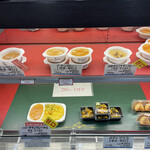
自称カレー王
4.10
Namaste. I am the self-proclaimed Curry King. This is the delicatessen of the long-established Indian restaurant "Ajanta" in Seibu Ikebukuro. Whenever I go to Ikebukuro, I always end up buying from here. If you go to Ikebukuro, you have to stop by here, or else you'll be missing out, I think. The key feature of Ajanta's Keema Curry is its strong spiciness and refreshing spiciness. It has a dry finish with green peas. It's like Keema Matar, right? Even if you can't go to the restaurant, you can still buy it at Seibu Ikebukuro, so you have to buy it. When I got home, I grilled some naan, paired it with pickles and achar, and ate it. Honestly, it's much tastier than eating at an average restaurant. Of course, it goes well with rice too. By the time I finished eating, I was sweating. Maybe the spiciness was from the green chili pickle. Don't underestimate takeout. It's seriously the best souvenir. I think the filling in the curry bread is also the incredibly delicious Keema Curry, so I recommend that too! That's what I think.


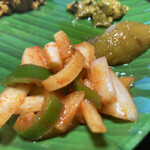
自称カレー王
4.00
Hello. I am the self-proclaimed Curry King. Have you all tried Osechi dishes? I, who eat spicy food every day. Today, I will introduce what I am eating during the New Year. This is highly recommended for spice enthusiasts like me who never miss out on curry even during the New Year! Well, there aren't many of us, I guess. Haha.
Ajanta's New Year Osechi Delicatessen
Located on the basement 1st floor of Seibu Ikebukuro, the renowned restaurant "Ajanta" has a deli shop. This place is the best. It offers a unique and spicy assortment of hors d'oeuvres that are different from traditional Indian cuisine. There are spicy grilled chicken, spicy swordfish fry, spicy shrimp fry, chicken curry, and cauliflower. Everything from the dishes to the side sauces is delicious. And of course, they have a definite spiciness because it's "Ajanta". This is truly my Osechi. The portion is just right for a single person. It's a perfect amount to add a little variety to the usual New Year dishes. Consider it for next year's New Year. By the way, I was planning to buy curry bread as well, but it seems they are currently on break. This deli shop is always worth keeping an eye on.
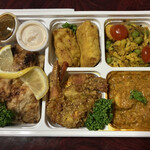
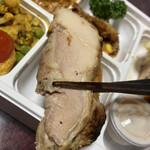
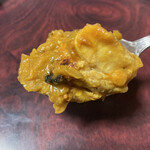
自称カレー王
4.30
Hello. I am the self-proclaimed Curry King. October 2nd. After receiving a strong tip from a dear reviewer saying "This one is dangerous," the Curry King has caught wind that the culprit to be arrested is in Ikebukuro today. The target is the heavyweight of the Indian cuisine world, 'Ajanta'. The suspect was found in a deli shop in the basement of Seibu Ikebukuro. Ajanta's curry bread must be arrested, and there will be no playing around this time. Microwave for 10 seconds, then bake at 180℃ for another 2 and a half minutes before devouring it. The curry bread is a fried type and relatively large in size. The filling is a spicy dry keema curry with a carefully made outer layer. When described in words, it may sound ordinary, but it is far from it. The spiciness of the curry bread filling is abnormal, like a special Indian version of keema matar. Additionally, when you sandwich the crunchy onion achar that was purchased separately between the bread, ohhh! Amazing! The moment you take a bite, you'll be transported to India. This is a curry bread that cannot be made by a regular bakery. Impossible! You can only eat it here. Priced at 400 yen, it is on the higher side for a curry bread, but this is definitely a quality that you can only get by paying 400 yen. It's a curry bread for adults who are willing to pay to eat it. Indeed, Ajanta's curry bread was extraordinary. I have arrested many curry breads in the past, but this was the most intense and spicy curry bread arrest in my history.
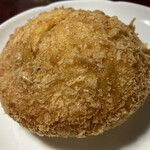
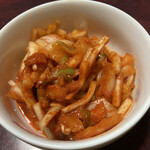
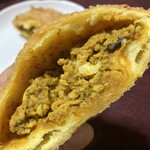
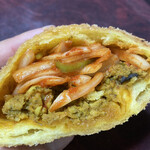
ねこあし85263
3.60
To make up for the subtle lack of spice, I headed to Seibu Ikebukuro B1. I was drawn to the Tandoori grilled trio set (Seekh Kebab, Tandoori Chicken, Fish Tikka) with a sign saying "It's a party when you open it" by the lady at the counter. My cat-like instincts couldn't resist the temptation. The set costs 1371 yen and includes three generous portions. The Seekh Kebab, Tandoori Chicken, and Fish Tikka are all flavorful and well-sized. The Tandoori Chicken is the spiciest, but the others also pack a punch later on. The flavors are authentic and satisfying. The highlight was the limited edition curry bun, with only 6 available per day. The curry filling is rich and spicy, making it a unique and delicious treat. A must-try for anyone looking for authentic Indian flavors outside of a restaurant setting.
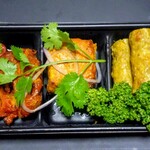
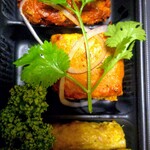
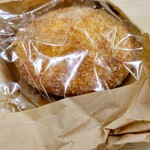
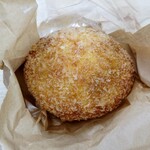
ねこあし85263
3.60
Ajanta is a well-known deli shop located in Kojimachi, one of the hundred famous shops. I purchased Chicken Curry (small), Cheese Naan, and Curry Bread for a total of 1533 yen. I couldn't decide on the curry, but the staff recommended the Chicken Curry by saying it's as spicy as Keema. When I opened the lid, the aroma of cloves hit me, and the curry had a strong spicy kick that was balanced by the refreshing coriander. The Cheese Naan was a bit dry, likely due to being baked earlier, but I never expected to find such high-quality curry at a department store basement. The Curry Bread was also luxurious with rich spices and a generous amount of spicy Keema filling. It was my first time feeling so satisfied with just eating curry bread. I've never seen Curry Bread at Ajanta before, but if I come across it again, I will definitely buy it (maybe even stock up and freeze it). Curry lovers should definitely try it. When you feel like you might miss out on good food, it's worth running to the department store basement.
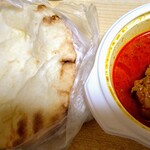
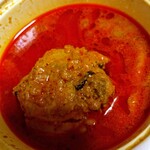
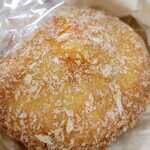
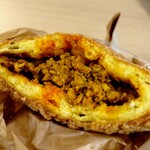
カレーおじさん\(^o^)/
3.70
One of the longstanding famous curry restaurants in Japan, Ajanta in Kojimachi, has a takeout-only shop in the Seibu Ikebukuro basement, which may not be well known. They offer discounts in the evening, making it a good deal. I purchased a small size mutton curry and cheese naan for breakfast the next day. I reheated them the next morning. Indian curry is often best enjoyed fresh, but this mutton curry was still delicious even after a day. It's quite spicy, almost as spicy as the mutton curry you would have in India. However, that's what makes it delicious. It's so spicy that it might be too much for those not used to spiciness. The cheese in the naan didn't melt, but that actually made it light enough for breakfast. It's truly a top-notch restaurant. Even as a takeout, the quality was maintained.
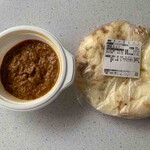
ソルヒャン
3.30
It was unusual to see discounts starting in the department store basement around 5:30 pm. I was wandering around looking for a snack to go with my drinks - what should I eat? Suddenly, I stopped at a section that caught my eye, thinking, "I haven't had curry recently." I couldn't take my eyes off the Biryani in the case of a spice-deficient situation. It was 200 yen off - I bought the Chicken Biryani and Achar without looking at the store name. I remember eating at this place before at "Oshokuji Chuubou". This time, I bought the Chicken Biryani thinking it looked delicious, and it didn't disappoint - it was really good. The yogurt salad that came with the Biryani was delicious. The yogurt salad enhanced the deliciousness of the Biryani, and I could eat it endlessly. The Achar was tasty but quite spicy. The Chicken Biryani, yogurt salad, and Achar went well with beer and were very delicious. It was so delicious that I think this shop is very useful for shopping in the department store basement.
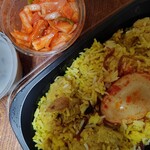
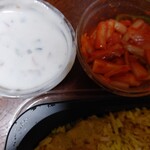
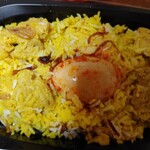
ロロノア・初老
4.00
I went to Ikebukuro to eat curry udon and Thai food, and on the way back, I stopped by the Seibu department store basement. There are so many small shops that it's impossible to count them all. The partitions between the shops are also confusing, with some people accidentally ordering from the neighboring shop. My goal was Ajanta. I was looking for snacks, not bento boxes or naan & curry. Looking inside the case, I found some snacks, but they were all spicy. I couldn't find anything to buy. After some hesitation, I decided to purchase the Shrimp Masala (180g for 929 yen). It's medium spicy and has a lot of shrimp, so it seems like a good snack. The bag was extra, so the total was 931 yen. When I got home and tried it, it was quite spicy. It's much spicier than the usual medium spicy. But it's not just spicy, there's also a sweetness from the vegetables. It's filled with plenty of vegetables like onions and green peppers. There are even 4 plump shrimp. The curry doesn't have much sauce, and it feels like they used a generous amount of ingredients. They also sold naan, but I think rice would go better with this curry. It's truly authentic curry, different from regular curry. But next time, I think I'll go for the mild version. The medium spicy was too spicy. Thank you for the meal.



ropefish
4.00
Did you know that there is a pioneer of Nippon Indian cuisine, "Ajanta," located in the basement floor of Seibu Ikebukuro Main Store? It is not the same as the "Ajanta Main Store" in Ikebukuro. Established in 1957, Ajanta is a trailblazer in Japanese Indian cuisine. It operated for a long time in Kudanshita, producing many Japanese Indian cuisine chefs. The chefs who trained at Ajanta have opened renowned restaurants like Sitar in Kichijoji, Saarnath in Funabashi, Wakonin Saidentoru in Hatsudai, Anjuna in Takahata Fudo, Kelara in Mashiko, Chittira in Sendai, Ganesha in Nomiya-dai, Saraju in Urawa (now closed), Chaihana Kaika in Oita. Ajanta has played a significant role in popularizing regional Indian cuisine in Japan. Renowned chef Rei Watanabe, who introduced South Indian cuisine, also learned Indian cuisine in Ajanta's kitchen. Ajanta once had a restaurant in Seibu Ikebukuro Main Store's food section, where Tandoor, an Indian cuisine takeout, was located. It opened on December 1, 2020, in the spot vacated by Tandoor. Currently, Ajanta has only two outlets in Kojimachi and Ikebukuro. They offer takeout only. However, Seibu Ikebukuro Main Store has a relaxing rooftop area, so you can enjoy your meal there. The lineup includes curries, grilled dishes, deli items, and biryani from North and South India. This time, I chose the following: Ikebukuro Bento Box for ¥1010. Don't underestimate it as a typical department store bento. The vegetable curry and keema curry combination is impressive. The large-cut vegetables are flavorful, and the keema curry is spicy and full of spices. The pickled spicy onions are also a specialty of Ajanta. The quality surpasses that of most Indian restaurants. This is because the preparation is done in Kojimachi, maintaining the taste of the main store. The naan is baked in Ikebukuro. Even as takeout, you can feel the legendary quality of Ajanta. It is safe to say that it offers the best Indian cuisine bento in Ikebukuro.
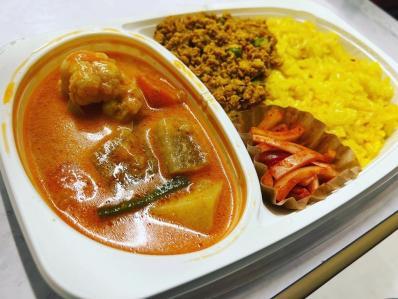
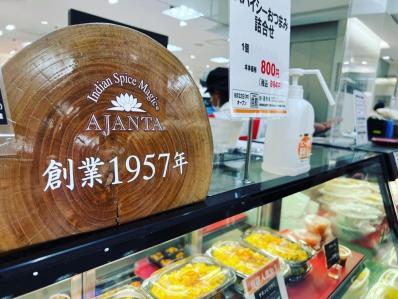
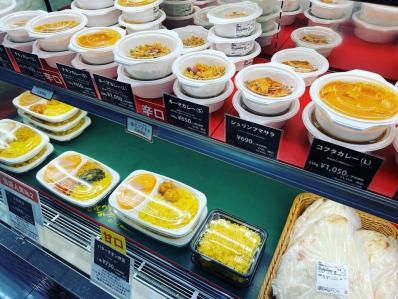
sakana_
3.10
Ajanta Seibu Ikebukuro Main Store
I finally visited Ajanta after hearing they had opened a store in the department store basement. However, I was a bit puzzled by the lack of appealing items on display. The staff, who seemed to be from South Asia, had a nice atmosphere though.
- Ikebukuro Bento ¥789
Vegetable Curry: Simple spice usage with cauliflower, daikon, carrots, and green beans.
Keema Curry: A slightly spicy chicken keema that adds variety to the meal.
Turmeric Rice: Fragrant with cumin seeds.
Onion Achaar: A nice touch to have on the side.
The menu mentioned that the most popular item was Chicken Biryani, but the small pack for ¥1188 seemed to be priced for a department store. (3.08)

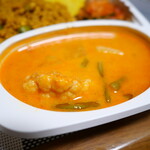
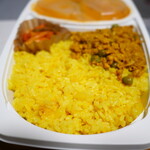
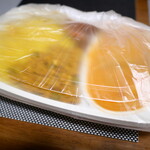
ikuyo
3.50
This is a takeout-only shop of the popular curry restaurant "Ajanta" in Kojimachi. Although I often go to Seibu Ikebukuro, I had never used this shop before, so I decided to try it out and purchased items such as biryani and tandoori sets. I bought ■Achar (200 yen) ■Chicken Biryani (1,100 yen) ■Vegetable Biryani (1,100 yen) ■Tandoori Assortment (900 yen). Since curry with rice was always butter chicken or vegetable curry, I decided to go with biryani instead of a curry bento. The fluffy rice with a perfect amount of spiciness was exquisite. There were two types of tandoori dishes: one with meat and one with shrimp and vegetables, and I chose the latter. It was perfect as a snack and very delicious.

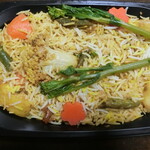
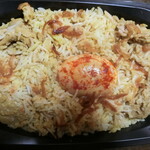
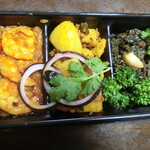
ひき肉は肉ではない。
3.00
After work, I wandered around Seibu Department Store basement in Ikebukuro to buy dinner. I decided to try lamb curry and corn rice. The lamb curry was surprisingly spicy for me, who isn't good with spicy food, so I couldn't finish it all. The taste was okay, but I ended up just eating the meat and vegetables. I didn't have high expectations for the corn rice, but it turned out to be surprisingly delicious with the fluffy rice and sweet corn matching well together. Thank you for the meal.
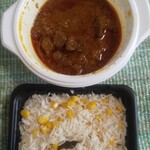
白いちごタルト
3.50
This is a shop in the depachika (basement food floor) of Seibu Ikebukuro Department Store that serves Indian curry. They also sell naan and other Indian dishes. I was intrigued by the curry bread and samosas displayed on the showcase, so I decided to stop by. The curry bread was a decent size, and the samosas had a nice golden color. I bought a potato samosa and enjoyed it on the rooftop terrace of Seibu Ikebukuro. Even though it would have been better heated, I couldn't resist and took a bite right away. The samosa was filled with vibrant yellow potatoes and was spicier than I expected. The crispy skin added a nice texture, and despite its size, I didn't get tired of eating it until the end. It was so delicious that I found myself thinking, "I want to eat that samosa again!" as I left.

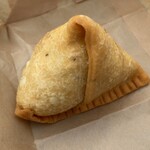
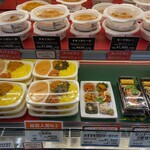
fukuoka2525
3.50
I stopped by on my way back to the office after shopping in a hurry and bought some food. Normally, I don't use takeout much because I prefer to eat warm food right away, but I was short on time today. I bought Chicken Biryani and Samosa for 1500 yen. I apologize for the appearance in the photo as it got flipped over while reheating. The Biryani, which I don't often have the chance to eat, was very delicious and light. It had chicken, half a boiled egg, and fried onions as ingredients. When I heard a crunchy sound while eating, I found whole cardamom in it. The small amount of fried onions added a nice touch. The Samosa was mostly potato but had a good kick of cayenne pepper, making it tasty. It came with a yogurt-based dressing, but I didn't use it.
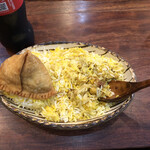
英昭
3.80
When I come to Ikebukuro, I often buy from this store. On this day, I bought a product that I had never purchased before because a person next to me was buying a large quantity of it and it made me want to try it. The curry bread was delicious without being too oily. The chicken tikka chapati roll, which was wrapped in an egg chapati, had a mild flavor that I personally found a bit bland, so I also bought shrimp masala to eat it with, which made it tasty. The seekh kebab, like grilled chicken, loses its juiciness when taken home, but you can still enjoy the flavor without losing the meat juices.
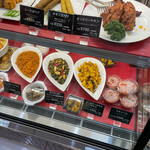
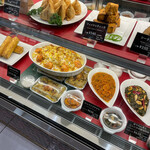

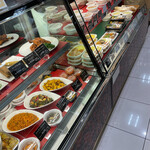
英昭
4.10
The curry I took out was delicious, so I revisited the restaurant. I ordered Chicken Curry, Golden Potato Masala (slightly less in quantity due to a 50 yen discount), and Chicken Liver in Madras (not sure of the exact name). The curry shop in the department store basement offers popular curries for takeout, and I enjoyed it last time, so I went back. When I checked the ingredients of the curry at home, I realized they suited our taste preferences, which may be why it tasted so good. The three dishes I bought this time were all very spicy, not recommended for those who are sensitive to spicy food. The spiciest was the meat inside, which was extremely hot and made me sweat from my scalp when I bit into it. Despite the spiciness, the curry was delicious, and I would like to buy it again.

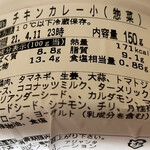
英昭
3.70
I found out that a popular curry restaurant in Yurakucho that I saw on TV offers takeout in Ikebukuro. I visited and had a set of Tandoori chicken and curry (around 1200 yen?) along with shrimp masala (630 yen) to take home. When I opened the bag at home, I could smell garlic, probably from the Tandoori chicken. The Tandoori chicken was tender with a slight firmness, and the spiciness was not extremely hot but quite spicy. It was delicious, but it didn't really captivate me. The curry had no strong flavor, making it easy for Japanese people to eat. There are few restaurants in Seibu Ikebukuro that suit my taste, so having more options is great.

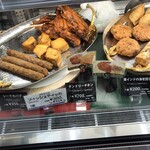
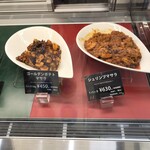

ちゅーか
3.40
There used to be a different Indian curry restaurant in Seibu, but now it seems to have changed to Ajanta. My son wanted to eat curry and naan, so I chose butter chicken and cheese naan, which were described as sweet. I also bought a 6-piece assortment of side dishes for dinner. We tried them for lunch. The naan was a bit firm. The curry had a mild taste with the sweetness of vegetables, butter, and cream. It was delicious and not too spicy, suitable for kids or those who don't like spicy food. We also tried the side dishes for dinner. The spiciest one was made with potatoes, but it went well with alcohol. The chicken liver dish was also spicy and tasty. The tandoori chicken was decent, but another chicken dish was a bit tough. The least favorite among my family was a bean croquette-like dish, which was dry and not suitable as a side dish or an appetizer. Overall, the balance was good, and I would consider buying from there again.
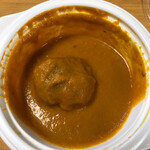
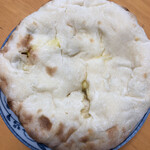
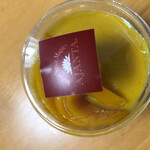
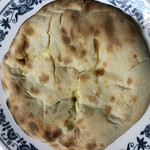
Email Login